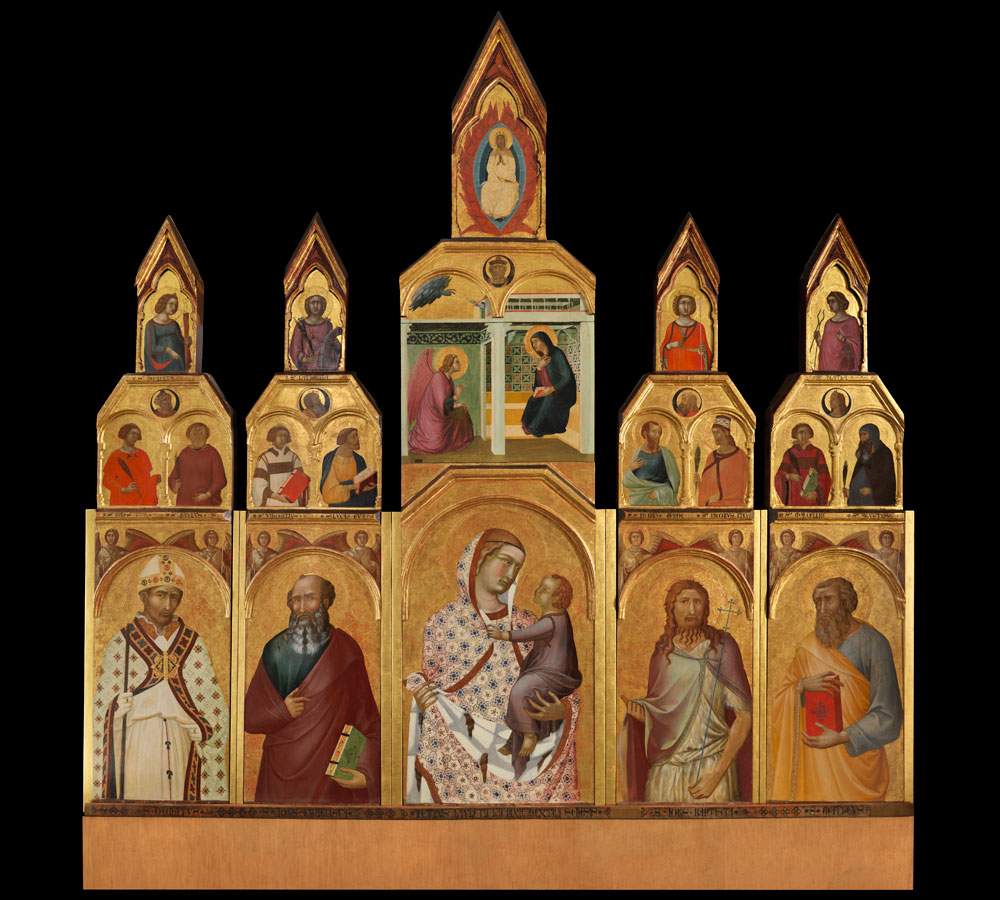Fourteenth-century masterpiece by Pietro Lorenzetti returns to Arezzo after lengthy restoration
After six years of restoration, one of the masterpieces of the 14th century, the Madonna and Child, Saints, Annunciation and Assumption by Pietro Lorenzetti, better known as the Tarlati Polyptych after the name of its commissioner, Bishop Guido Tarlati, is coming home to Arezzo. The polyptych will then be relocated to the Pieve di Santa Maria. Unfortunately, due to the health emergency, the events planned for the work’s return have been postponed until a later date. In any case, an important work of cleaning, consolidation and securing is concluded, returning one of the undisputed masterpieces ofmedieval art.
It is a tempera on panel with a gold background made between 1320 and 1324. This is documented in the contract signed on April 17, 1320, by which Bishop Guido Tarlati binds the Sienese master, expressly asking him to paint beautiful figures with fine colors, in fields gilded with gold from a hundred florin sheets. The document, which testifies to the work-artist-contractor relationship, requires the painter to commit himself without interruption and without taking on other commissions until the work reaches perfection, and specifies that it is up to Bishop Guido and the canons of the Pieve to approve the finished panel (agreed upon for one hundred and sixty Pisan lire). Pietro Lorenzetti truly achieved perfection: the painting pleased the patrons and was placed on the high altar of the Pieve, where it will now be relocated.
The polyptych has arrived to this day devoid of significant structural parts, such as the two columns placed at the ends with six painted figures on each, which were meant to make it self-supporting by supporting it to the ground; also missing is the predella, which Giorgio Vasari described as having “many small figures, all truly beautiful and conducted with very good manner,” and the small pillars between the compartments ending in pinnacles are missing.
The last restoration was carried out in 1976, and almost forty years later, the review of the restoration of Pietro Lorenzetti’s Polyptych was essential. After the appropriate analyses, the functionality of the support was verified, then a cleaning of the pictorial surface was carried out to remove layers of restoration from the last intervention (varnishes and pictorial integration, altered over time). This operation revealed extensive areas of paint and gold backgrounds in which obvious layers of dirt and ancient patinas of difficult dating persisted. A second phase of very delicate cleaning, conducted entirely under a microscope, was then imposed, which allowed the recovery of the iridescent colors and extraordinary decorations conducted freehand by the painter.
A special research phase, in close collaboration with the Superintendence of Siena Grosseto and Arezzo, was dedicated to the hypothesis of reconstruction of the structural wooden parts of the monumental frame, unfortunately lost, which made it a self-supporting machine of great visual impact. Hence, a hypothetical reconstruction was proposed, with digital drawing, that would allow the correct spacing and proportions to be restored to the work, facilitating its reading in relation especially to the monumental interior of the Pieve for which it was conceived. We limited ourselves, as far as the reconstruction was concerned, to the recovery of the width of the polyptych: gilded laths were inserted to distance the various parts of the work, bringing it back, at least in width, to its original size.
The restoration site was set up in the RICERCA studio, and restorers Paola Baldetti, Marzia Benini and Isabella Droandi carried out intensive educational and outreach activities, in the laboratory, in collaboration with Aretine schools of all levels, and with Italian and foreign university students. The restoration has been self-financed since 2014 by RICERCA and, since 2017, with the support of ART ANGELS AREZZO Onlus. In addition to private Italian and foreign citizens, funds already raised amounting to 302 thousand euros have been donated by Fondazione Cassa di Risparmio di Firenze and companies in the Arezzo area, as well as by Friends of Florence. Sums of 77,980 euros still remain to be financed for essential interventions for the correct relocation of the work in the church.
In this regard, a fundraising campaign is underway on the GoFundMe platform at the link: https://www.gofundme.com/f/progetto-restauro-lorenzetti
Pictured is the polyptych after restoration.
 |
| Fourteenth-century masterpiece by Pietro Lorenzetti returns to Arezzo after lengthy restoration |
Warning: the translation into English of the original Italian article was created using automatic tools. We undertake to review all articles, but we do not guarantee the total absence of inaccuracies in the translation due to the program. You can find the original by clicking on the ITA button. If you find any mistake,please contact us.



























